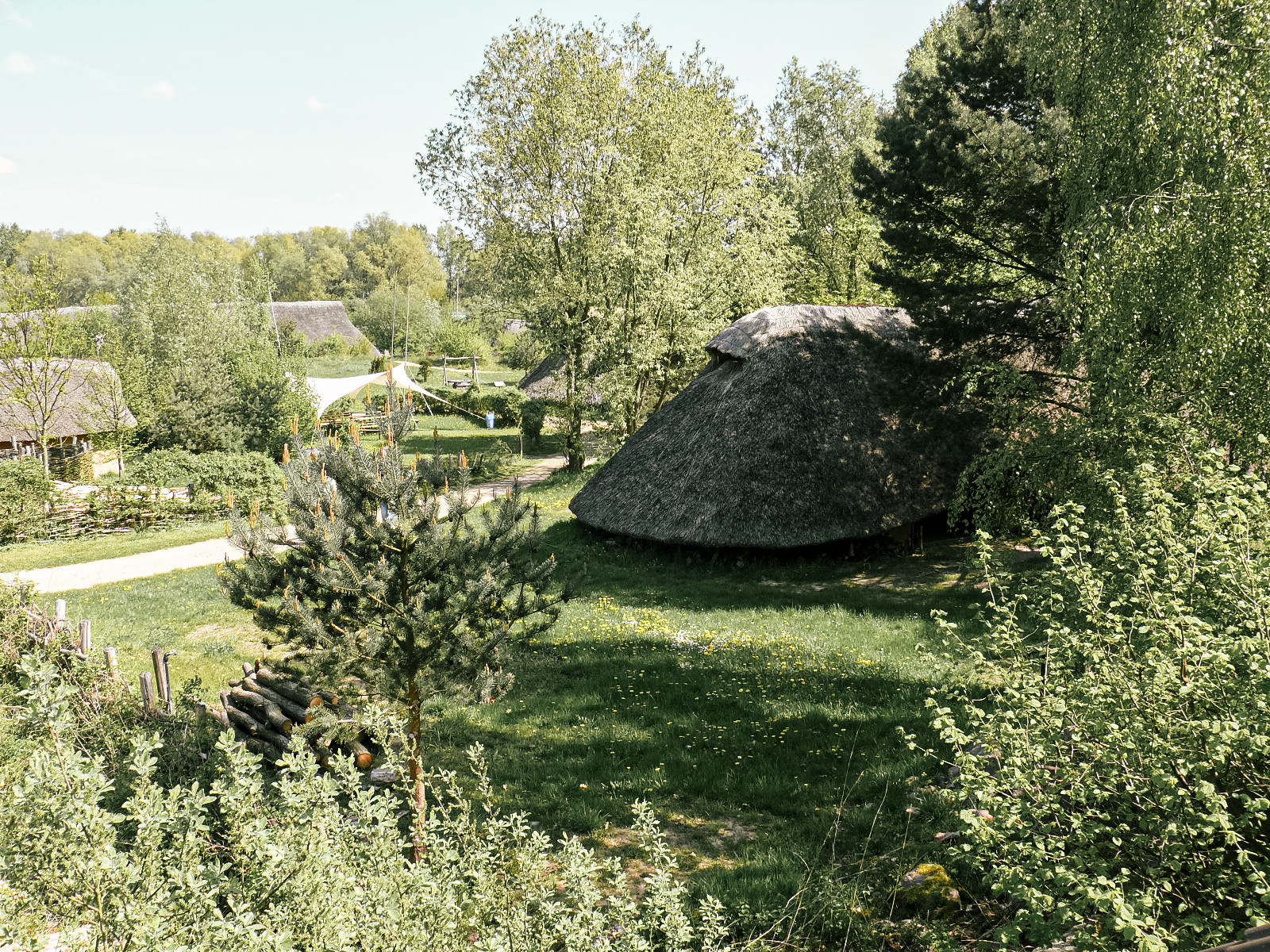From the excavation...
… to the museum
From the settlement…
Into the Bronze Age
This groundbreaking invention was made in ancient Mesopotamia. Around 2,000 BC it found its way to what is today Lower Saxony. In Hitzacker (Elbe), the settlers who have lived here since the Neolithic period quickly learned to appreciate the new material. The settlement boomed and life flourished along the Elbe – an important long-distance trade route throughout the ages – for over 1,300 years.
Celebrations and conferences in our cozy longhouses
Anniversary, birthday party or company function With us your celebration will happen in a stylish setting! A festive table, an individual program, beautiful grounds to relax in – we offer space for up to 100 guests in our longhouses.
Forschung
Touching the Bronze Age
In order to tangibly explain the house plans of the prehistoric settlement, which are hard to recognize even for experts, we have built three different longhouses as walk-in, life-size models. The construction was made possible with the help of experimental archeologists, craftsmen, structural engineers and architects. The entire museum grounds were landscaped with trees and plants that have been proven to be from the Bronze Age.
- We work in the field of “experimental archaeology”.
- We have made the interrelationships between people and the environment one of our main topic.
Mission statement
We are service providers and partners of current and future cultural, scientific, social and economic projects. We work cooperatively and are networked through Germany and Europe. The maxims of our work are based in professionalism and cost-effectiveness in the following areas of activity:
- Make archeology understandable
- visitor-friendly and educational-oriented
- ecological and sustainably
- economical and professional
- networking and cooperative
- strengthening and shaping the identity of the region
- Respectful and employee-oriented
- Citizen-oriented and committed
Affiliate links
Wendland.Elbe
We actively work together with the tourism portal Wendland.Elbe.
Hitzacker (Elbe) is also an ideal starting point for cycling and hiking tours:
www.outdooractive.com
Marketing office Wendland.Elbe: www.wendland-elbe.de
Biosphere Reserve “Elbe River Landscape”!
We are partners of the UNESCO Biosphere Reserve “Elbe River Landscape”!
www.elbtalaue.niedersachsen.de
Music festivals
Twice a year Hitzacker (Elbe) hosts two very special music festivals: the Hitzacker Music Week and the Hitzacker Summer Music Days.
Hitzacker Music Week:
www.musikwoche-hitzacker.de
Hitzacker Summer music days:
www.musiktage-hitzacker.de
Hitzacker spa and tourist information centre
Am Markt 7 / 29456 Hitzacker (Elbe)
Tel.: 05862 – 96 97 0
E-Mail: touristinfo@hitzacker.de
www.hitzacker.de
Selection of group-accommodations:
Youth hostel Hitzacker
The youth hostel is located in the middle of the forest, about a 20 to 30 minute walk from the historic city centre. The modern hostel is also disabled-friendly. The youth hostel is a member of the German Youth Hostel Association and has 165 beds in 2-, 4- and 6-bed rooms. Day and lounge rooms, a music room, volleyball court, table tennis, chess, barbecue area, etc. are available.
Jugendherberge Hitzacker, Wolfsschlucht 2, 29456 Hitzacker
Tel.: 05862/244
Fax: 77 67
www.jugendherberge.de/jh/hitzacker/
Meudelfitz youth recreation centre
The recreation centre with 50 beds in A-frame houses, additional campsites and excellent facilities for self-catering groups is located about 4 km from Hitzacker.
Familie Bredow, Bleckeder Landstraße, 29456 Hitzacker-Meudelfitz
Tel. 04139/7497
www.jugendfreizeitanlage-meudelfitz.de
The destinature village
Family-friendly holiday village with bistro and outdoor spa facilities. Spend the night in and with nature very close to the Hitzacker Archaeological Centre. More information at:
www.destinature.de
Archaeological Societies
Association of Archaeological Open Air Museums:
Archaeological Open Air Museums and other facilities involved in Experimental Archeology (Exarc) www.exarc.eu
European Association for the Promotion of Experimental Archeology (Exar) www.exar.org
The Scientific Book Society (wbg)
www.wbg-kulturcard.de
Archaeological open-air museums
www.starigard-museum.de
www.afm-oerlinghausen.de
www.pfahlbauten.de
www.aoeza.steinzeitpark-albersdorf.de
www.gross-raden.de
www.bronzezeithaus.de
www.bronzezeithof.de
www.eisenzeithaus.de
www.heimatverein-greven.de/der-sachsenhof.html
Archaeological-themed Museums
www.museum-vietze.de
www.NaturundMensch.de
www.helmsmuseum.de
www.landesmuseum-hannover.niedersachsen.de
Museum Societies
Museumsverbund Lüchow-Dannenberg e.V. www.mvld.de
Museumsverband Niedersachsen und Bremen e. v. www.mvnb.de
Cooperation partner “Universities”
www.uni-hamburg.de
www.fu-berlin.de
Tourist institutions
Kultur- und Tagungszentrum Hitzacker (Elbe) www.verdo-hitzacker.de
Elbe und Elde Schiffstouren Reederei Heckert www.elbtallinie.de
Deutsche Bundesbahn www.fahrtziel-natur.de
Waldmuseum Naturum Göhrde www.naturum-goehrde.de
Das Alte Zollhaus Hitzacker (Elbe) www.museum-hitzacker.de
More partners
Ur- und Frühgeschichtliche Keramik www.urkeramik.de
Gewänder aus allen Zeiten www.ch-hoffmann.de
Lederwerkstatt Sattler www.lederkoecher.de
Atelier für Grünholzgestaltung www.gruenholz.info
www.eisenherz-schmiede.de
Haupt- und Realschule Bernhard-Varenius Schule www.bernhard-varenius-schule.de
